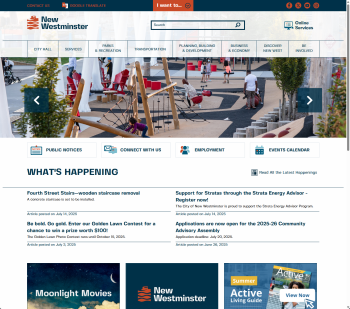City of New Westminster
New Westminster, founded in 1859 and incorporated as a city in 1860, was the first city in British Columbia and served as the colonial capital until 1866. With a 2021 population of 78,916 (estimated ~86,000 in 2025), it covers 15.62 km², ranking second-highest in population density among Canadian cities.
Heritage & Culture
Nicknamed the "Royal City," downtown features preserved heritage buildings, Columbia Street’s ‘Miracle Mile’ boutiques, the Anvil Centre for arts, and landmarks like Royal Columbian Hospital (est. 1862). The city respectfully acknowledges its location on unceded lands of the Halkomelem-speaking peoples.
Demographics & Multiculturalism
Surging growth (11.2% increase 2016–21) reflects diverse demographics: European (50%), East Asian (14%), South Asian (~10%), and substantial Southeast Asian, Black, Indigenous, and others. Queensborough area hosts a prominent Punjabi Sikh community.
Economy & Infrastructure
New Westminster is a regional commercial and transport hub; the Shops at New West mall integrates with the SkyTrain station. Key employers include Fraser Health, Royal Columbia Hospital, educational institutions, and light industry.
Recreation & Events
Riverside walkways, parks, festivals, live music, theatre at the Anvil, farmers' markets and trivia nights reflect vibrant civic life. The city also supports robust community engagement via an online platform “Be Heard New West”.
Governance & City Services
Managed by Mayor Patrick Johnstone and New Westminster City Council, with administration offering municipal utilities, online payments, permit systems, and transit planning.
Assessment
New Westminster offers a rich, walkable urban experience shaped by historic character, nascent growth, and multicultural vibrancy. It is well-connected, service-oriented, and community-driven; future success depends on retaining its heritage identity while ensuring sustainable, inclusive growth.

